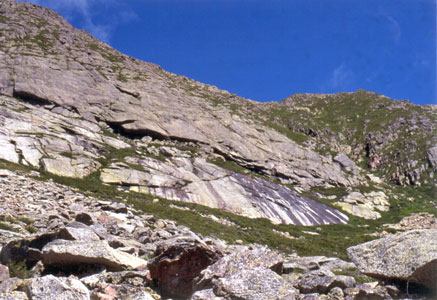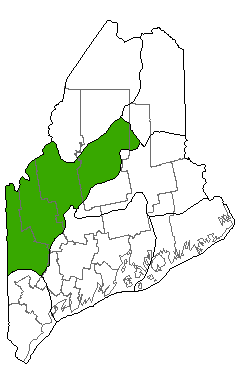DACF Home → Bureaus & Programs → Maine Natural Areas Program → Communities, Plants, and Animals → Natural Community Fact Sheets → Alpine Cliff
Printer Friendly Fact Sheet - 830 KB pdf (Get a free copy of Adobe Acrobat Reader)
Alpine Cliff
Scientific Name: Alpine Cliff; State Rank: S1

- Community Description
- Soil and Site Characteristics
- Diagnostics
- Similar Types
- Conservation, Wildlife and Management Considerations
- Distribution
- Characteristic Plants
- Associated Rare Plants
- Associated Rare Animals
- Examples on Conservation Lands You Can Visit
Community Description: Herbaceous - bryoid vegetation occurs with a mix of forbs and graminoids in patches over bare rock. Low heath shrubs including alpine bilberry and Labrador tea are present, but the distinctive feature of the vegetation is the herbaceous component. Several montane herbs, such as star saxifrage, hairy arnica, and alpine bistort, may be locally abundant on these seepy sites. The bryoid layer is extensive and may include large patches of the liverwort Scapania nemorea. Back to top.
Soil and Site Characteristics: Sites occur near or above treeline in seeps or rivulets, often associated with vertical to nearly vertical rock faces. The known locations are in cirques, with constant moisture, at elevations above 3000'. Back to top.
Diagnostics: Sites are at or above treeline, on sheer cliffs or cirque walls, usually with seepage; vegetation is a mixture of herbs, bryophytes, and dwarf shrubs; bulrush sedge is usually present along with other herbaceous species that do not occur at lower elevations. Back to top.
Similar Types: Other alpine community types occur either on drier substrates (lacking extensive bryophytes) or in boggy situations with peat mosses, cotton-grasses, and heath shrubs dominant. Subalpine Meadows may occur just below this community, but these are denser and the dominants much taller. Riverside Seeps may share some of the unusual species but are at lower elevations along major rivers. Back to top.
Conservation, Wildlife and Management Considerations: The known sites in Maine are on public lands or private conservation lands and somewhat removed from hiking trails. This vegetation is extremely sensitive to foot traffic, but given that access ranges from difficult to dangerous, the sites appear to be protected fairly well by their topography.
Alpine cliffs may provide nesting habitat for common ravens, peregrine falcons, and golden eagles. Back to top.


Distribution: Restricted in Maine to a few of the state's highest mountains (New England - Adirondack Province). Distribution outside of Maine unknown. Landscape Pattern: Small Patch. Back to top.
Characteristic Plants: These plants are frequently found in this community type. Those with an asterisk are often diagnostic of this community.
- Sapling/Shrub
- Mountain alder
- Shrubby cinquefoil*
- Squashberry
- Dwarf Shrub
- Alpine bilberry*
- Labrador tea
- Herb
- Bluejoint
- Bulrush sedge*
- Deer-hair sedge*
- Highland rush
- Low rough aster*
- Alpine bistort
- Alpine bitter-cress
- Arctic red fescue
- Bulrush sedge
- Hairy arnica
- Hornemann's willow-herb
- Mountain timothy
- Star saxifrage
- Golden eagle
- Peregrine falcon
Examples on Conservation Lands You Can Visit
| Example | County |
|---|---|
| Mt. Katahdin, Baxter State Park | Piscataquis Co. |